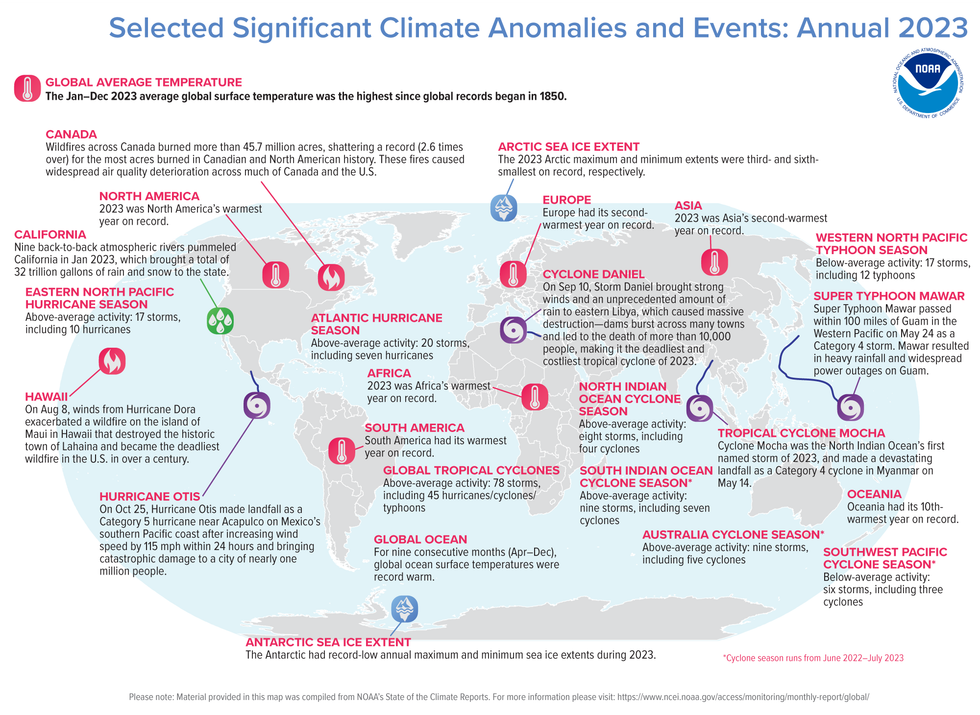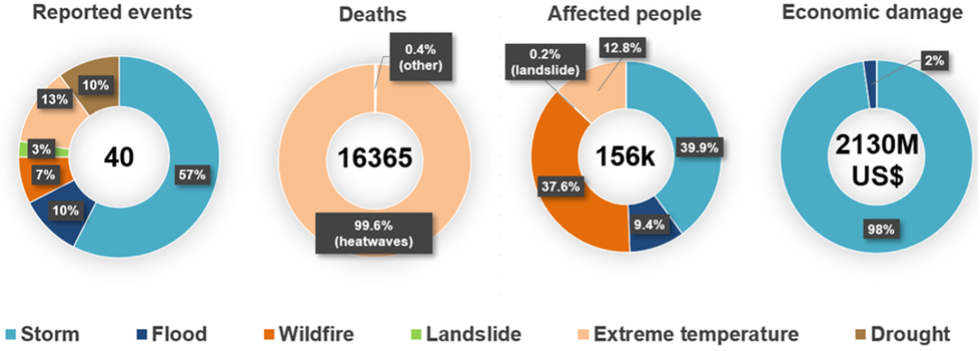The publication was presented at the 6th European Climate Change Adaptation Conference in Dublin, Ireland. Its key findings "paint a somber picture for Europe last year," according to C3S, which noted that the analysis shows the continent "is the fastest-warming of all the WMO regions, warming twice as much as the global average since the 1980s."
The other WMO regions are Africa; Asia; South America; North America, Central America, the Caribbean; and the Southwest Pacific.
"These supercharged extremes are wreaking havoc on livelihoods and infrastructure, including (ironically) the growing renewable energy sector."
In Europe last year, "the annual average temperature was between the second and fourth highest on record, depending on the data set used, and summer was the warmest," the report states. Countries including Belgium, France, Germany, Ireland, Italy, Luxembourg, Portugal, Spain, Switzerland, and the United Kingdom had their hottest year ever recorded—and though 2022 was "characterized by warm conditions, some areas were affected by cold spells and heavy snowfall."
"Precipitation was below average across much of the region," which "combined with high summer temperatures, contributed to the largest loss of glacial ice recorded in the European Alps," the document details. "The Greenland ice sheet continued to lose mass during 2022, and in September periods of exceptional warmth led to widespread surface melt."
"Sea-surface temperatures across the North Atlantic area of the WMO Europe region were the warmest on record and large portions of the region's seas were affected by strong or even severe and extreme marine heatwaves," the publication continues. "Drought also affected much of the region, particularly during spring and summer. The combination of dry conditions and extreme heat fueled numerous wildfires and the second-largest burnt area in the region on record."
C3S Director Carlo Buontempo highlighted in a statement that "the record-breaking heat stress that Europeans experienced in 2022 was one of the main drivers of weather-related excess deaths in Europe."
Specifically, emergency events across Europe last year directly affected 156,000 people and led to at least 16,365 deaths. Heatwaves represented only 13% of events but were tied to 99.6% of deaths. Floods, droughts, landslides, and wildfires were also reported, but 57% of events were storms, which caused 98% of $2.13 billion in total economic damage.

"Unfortunately, this cannot be considered a one-off occurrence or an oddity of the climate," Buontempo said. "Our current understanding of the climate system and its evolution informs us that these kinds of events are part of a pattern that will make heat stress extremes more frequent and more intense across the region."
Other experts and campaigners who responded to the report shared similar concerns for the future in a world still heavily reliant on fossil fuels and other sources of planet-heating pollution.
"This annual report is just a snapshot of the state of Europe's climate. It provides a sobering picture," said Hannah Cloke, a professor of hydrology at the U.K.'s University of Reading. "Extreme weather killed 16,000 people in Europe last year, mostly due to the effects of the summer heat. The loss of ice from the Alps was the largest ever recorded and comes on top of a downward spiral. Spain's ongoing megadrought means that water reserves are now so low that many farmers are unable to grow crops, which has a knock-on effect on food prices."
Cloke's colleague, climate science professor Richard Allan, noted that based on "the highest quality global and regional data," the analysis "finds 2.3°C of European warming since the Industrial Revolution and this is already increasing the severity of hot, dry, and wet weather events—these supercharged extremes are wreaking havoc on livelihoods and infrastructure, including (ironically) the growing renewable energy sector that is identified in the report as helping to tackle the root cause of warming by reducing the reliance on greenhouse gas emitting coal, oil, and gas."
"While pledges to tackle climate change could keep global warming below 2°C above preindustrial conditions, in the same ballpark as the Paris climate agreement targets, when only the most credible pledges are included, warming is expected to be more than 2.5°C by the end of the century," he added. "More ambitious and credible actions to cut greenhouse gas emissions and continued monitoring of these emissions and the heating they inflict are essential to avoid worsening damage from climate change across the continents and throughout the oceans."
The WMO-C3S report states that "wind and solar power represented 22.3% of European Union electricity in 2022, overtaking fossil gas (20%) for the first time. More electricity was generated by these two renewable resources than by any other power source."
Welcoming that positive takeaway, WMO Secretary-General Petteri Taalas stressed that "increasing use of renewables and low-carbon energy sources is crucial to reduce dependence on fossil fuels."
Taalas also emphasized that climate services, or the provision and use of climate information in decision-making, "play a key role in ensuring the resilience of energy systems to climate-related shocks, in planning operations, and in informing measures to increase energy efficiency."
Albert Klein Tank, director of the U.K.'s Met Office Hadley Center for Climate Science and Services, said in a statement that "the data in this report makes a vital contribution to the understanding of the changes we are seeing in Europe's climate."
"The data in this report makes a vital contribution to the understanding of the changes we are seeing in Europe's climate."
"Met Office research indicates that European citizens will need to prepare for new extremes," he warned, pointing out that the Italian island Sicily endured 48.8°C (119.84°F) in 2021 and Europe could soon see 50°C (122°F) for the first time. "A new record is likely at some stage soon—maybe even this year—and it is most likely to occur in the Mediterranean region during a period bringing in air from North Africa, where temperatures have also been rising markedly."
The Met Office on Friday released data showing that global sea surface temperatures for April and May were the highest on record for those months stretching back to 1850. In response, University of Bristol earth sciences professor Daniela Schmidt said that "the extreme and unprecedented temperatures show the power of the combination of human-induced warming and natural climate variability like El Niño."
"While marine heatwaves are found in warmer seas like the Mediterranean, such anomalous temperatures [in] this part of the North Atlantic, they are unheard of," Schmidt added. "As long as we are not dramatically cutting emissions, these heatwaves will continue to destroy our ecosystems."
The ocean revelations came a day after C3S announced that global mean surface air temperatures for early June were higher than previous data for the month "by a substantial margin," which Melissa Lazenby, a lecturer in physical geography at the University of Sussex, called a "stern warning sign that we are heading into very warm uncharted territory."




